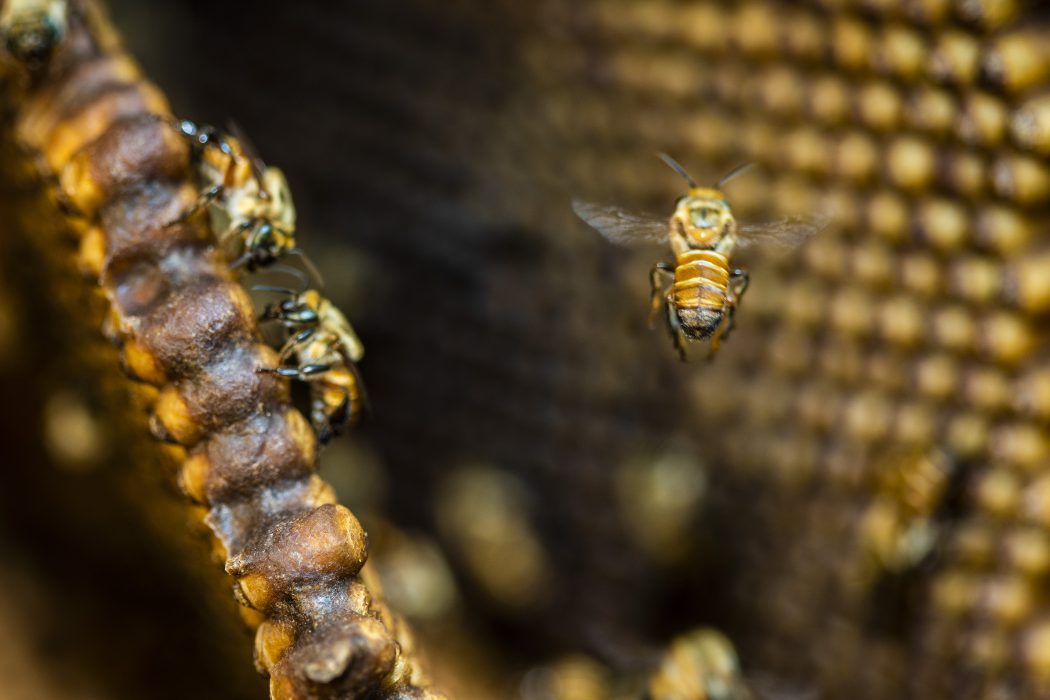By: National Geographic Explorers Rosa Vásquez Espinoza and Ana Elisa Sotelo
For centuries, communities in the Peruvian Amazon foraged for the hives of Amazonian stingless bees, meliponines, and used their honey and pollen to treat an array of conditions––from bronchitis and flu, to fertility (1,2).
During the COVID-19 pandemic, Iquitos, Peru became one of the hardest hit areas. Hospitals and cemeteries overfilled, and, by April 2020, mass grave sites were improvised to accommodate the dead. As cities became hotspots for disease and death, rural communities turned to traditional healing and knowledge to treat the sick, including using the unique honey of Amazon stingless bees.
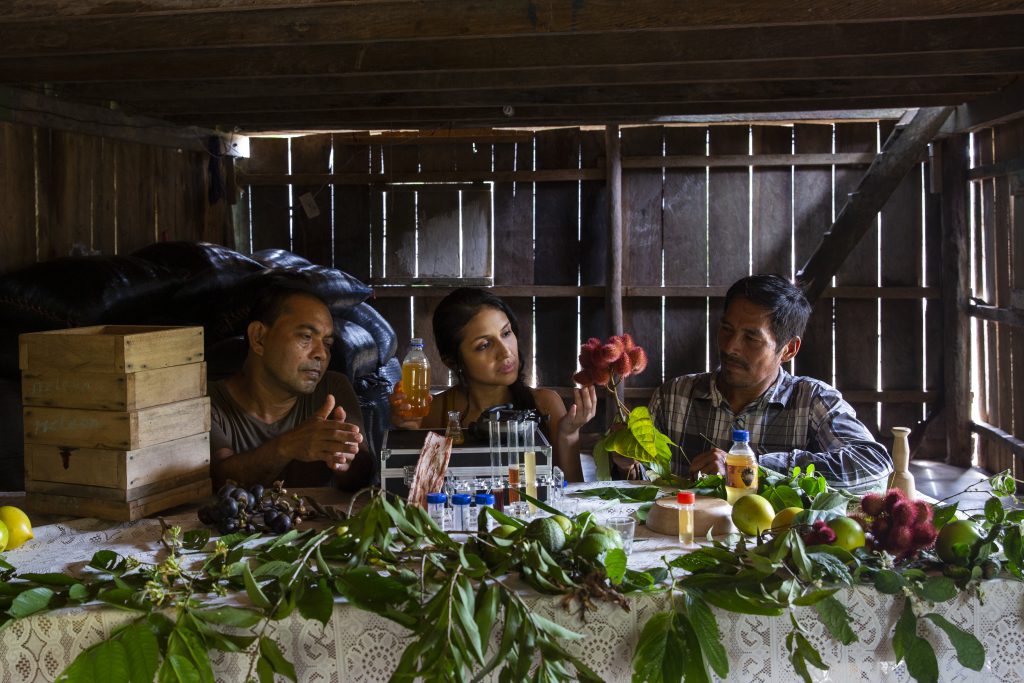
Community San Francisco, Nauta, Iquitos, Peru, 2021/12/16 – Rosa Vásquez Espinoza, National Geographic Explorer, biochemist and molecular biologist, studies bee hives, with Biologist Cesar Delgado (wearing green shirt) and local farmer Heriberto Vela (wearing plaid shirt), in a remote Peruvian community of the Amazon Basin.
For many Amazonian families, such as those in the communities of San Francisco and Chingana, beekeeping brought on much needed economic relief during the lockdown. During the pandemic, the demand and price for honey grew, and families were able to generate additional income from their home (1).
With support from the National Geographic Society, in December 2021, we traveled to outer Iqitos to learn about these bees and the medicinal properties of their honey. César Delgado Vásquez, who has been working with rural beekeepers in the area studying the links between the Amazonian stingless bee and plant diversity and growth, introduced us to a family of local beekeepers and to the magnificent world of
Amazonian stingless bees.
As we made our way up the Marañon River toward the town of San Francisco aboard a small speedboat and away from Nauta, the expanse of the forest became more visible, and its size was breathtaking.
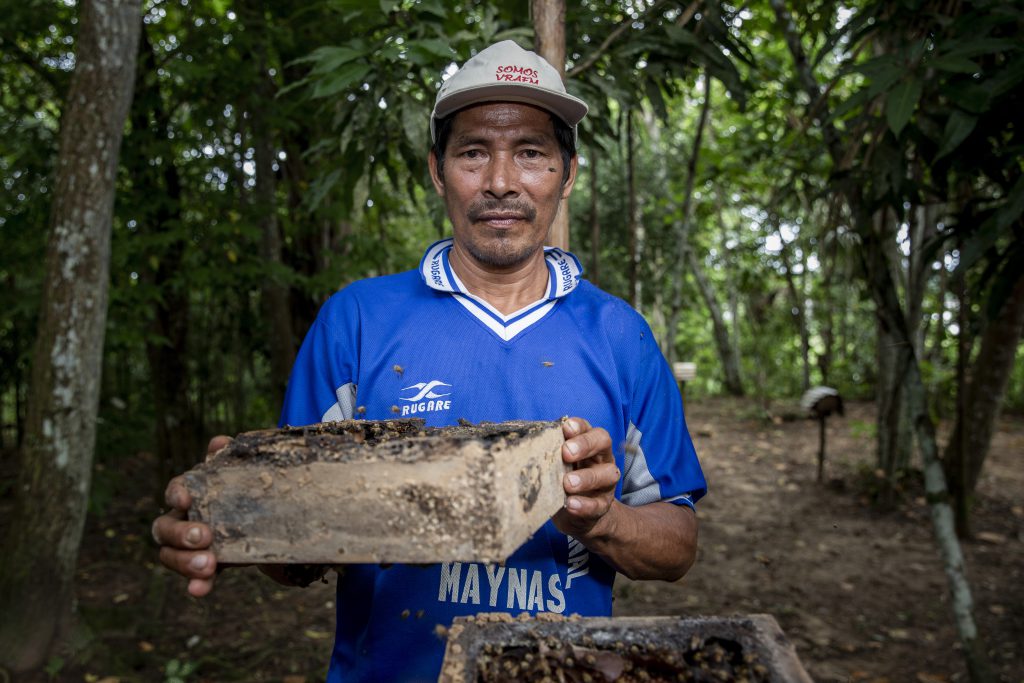
Local farmer Heriberto Vela, holding a beehive in a remote Peruvian community of the Amazon Basin.
In San Francisco, Heriberto Vela, his wife Roxana, and their numerous children welcomed us into their home and showed us their beehives. César has been working with Heriberto and other local families by helping them set up and care for Amazonian stingless beehives (3). Because the bees don’t sting, locals are able to have many hives set up behind their homes. Heriberto’s children played in the forest and watched curiously as we opened up one of the hives.
The smell was as intoxicating as the shapes, colors and structure. Dark-colored cells make up each layer of the five leveled hives, and each layer serves a specific function: honey storage, larvae growth, disposal of the dead, etc (3). César pointed out the hive entrance, pollen stores, and egg cells, and acquainted us with the way of life of the bees––all the while they flew around us with rapid wing beats, buzzing and harmlessly resting on our bodies.
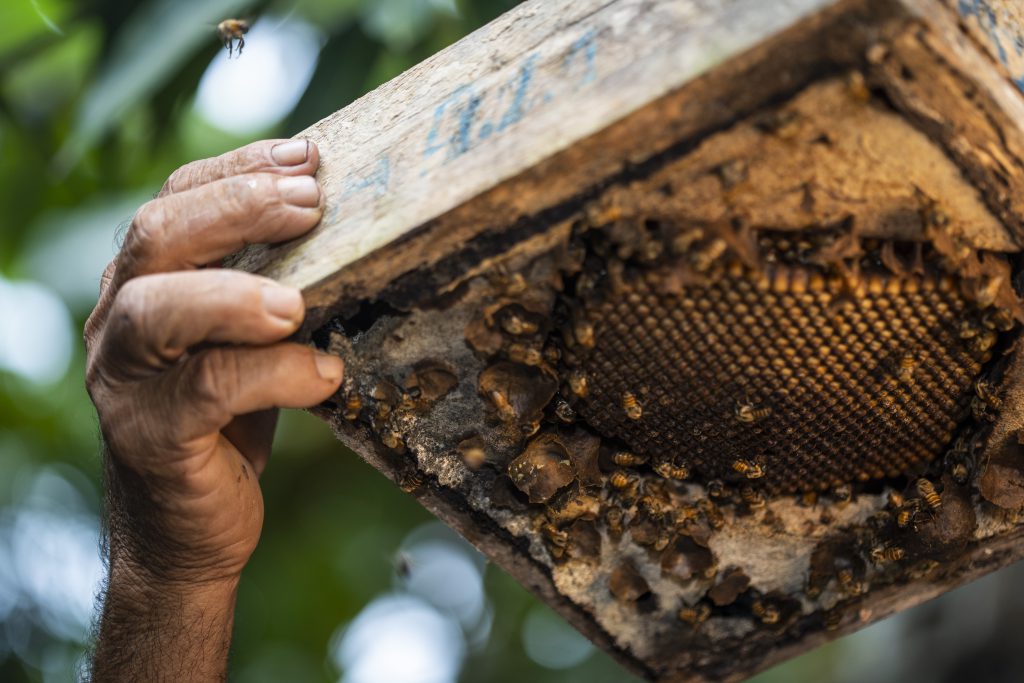
A local farmer holding a bee hive in a remote Peruvian community of the Amazon Basin.
It has been hypothesized that the bees’ honey acquires its medicinal properties from the plants they feed on, so Heriberto’s children gathered some of the plants for us. We examined the resin from Sangre de Grado trees (also known as dragon’s blood or Croton lechleri) which is used by the bees to build their hives and by locals used to treat diarrhea, infections, diabetes and cancer. We also examined the bright red achiote plant (Bixa orellana), which the bees feed on and locals used as a natural dye, for cooking and to treat constipation.
The pandemic devastated the Amazon Rainforest and the communities that depend on it as government vigilance decreased and illegal logging, farming, mining and contamination increased (4,5). Fortunately, the increase in beekeeping also brought on a rise of hard-working pollinizers, much needed in times of environmental crisis.
Previous research has shown that native bees are more effective in pollination of local crops than Apis mellifera (6). A recent study led by Peruvian entomologist César Delgado Vásquez in the Institute of Investigation in the Peruvian Amazon (IIAP) discovered that pollination associated with Amazonian stingless bees is directly contributing to an increase in the medicinal plant camu camu (Myrciaria dubia), with an up to 44 percent increase in crop yield (7). This result highlights the need to implement and promote meliponiculture practices in the Amazon to facilitate successful reforestation and strengthen agriculture productivity.
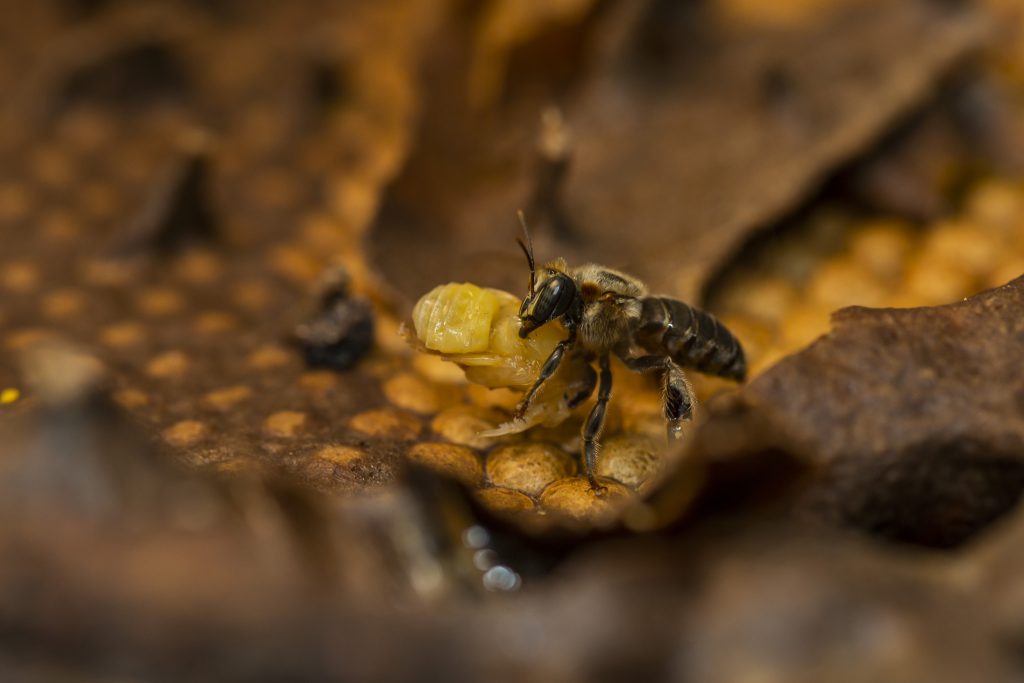
A bee carries dead larvae to the hive cemetery, inside a beehive in a remote Peruvian community of the Amazon Basin.
With Heriberto, we looked at the camu camu plant––which contains 30 times more vitamin C than oranges (7). By keeping multiple hives, Heriberto was contributing to the availability of these much needed plants in his agricultural crops.
We asked ourselves: Could bees help bring life back to the Amazon? While an increase in bees cannot tackle the damage brought on by incessant deforestation and oil contamination, an increase in bee population is directly linked to an increase in production and maintenance of local plants.
Nowadays, multiple factors threaten traditional Amazonian beekeeping practices: gradual loss of traditional knowledge, deforestation, low production and cost of honey, and an increase in extreme events such as flooding and drought. But by promoting meliponiculture practices in communities, we move the needle in repairing and preserving fragile areas of the Amazon Rainforest that could be critical in combating climate change (1,6). Local beekeeping of native species also creates job opportunities for people who protect and take care of the land, securing economic growth for generations to come.
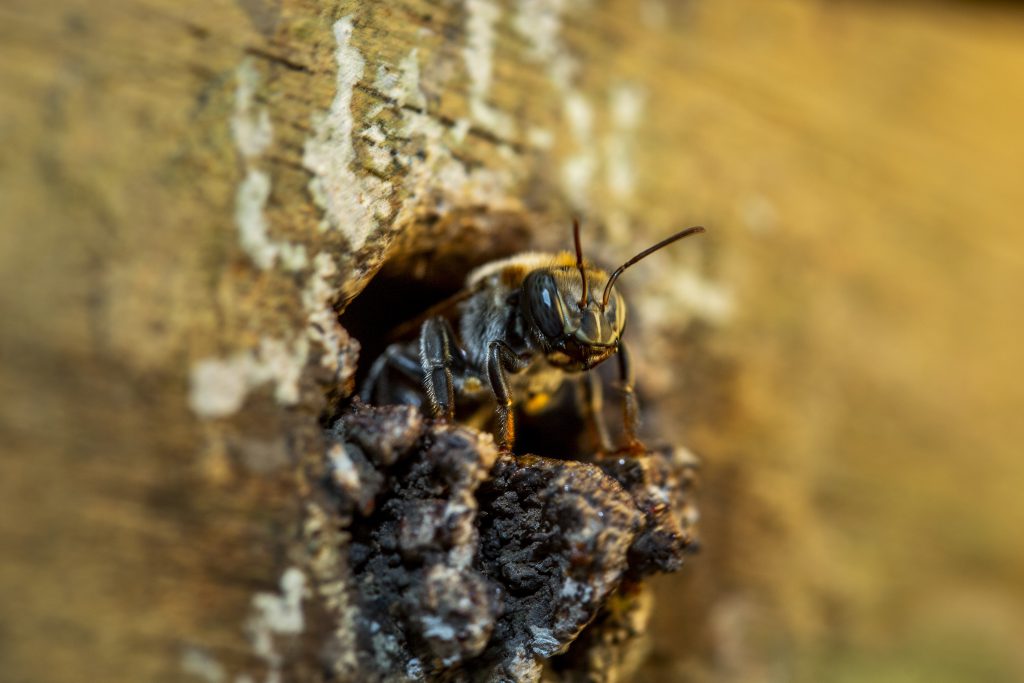
Close up on a bee hive entrance in a remote Peruvian community of the Amazon Basin.
Successful and long-lasting preservation of the Amazon Rainforest, its flora, fauna and microbial life, requires multidisciplinary and creative action. Supporting exploratory science endeavors that deepen our understanding of Amazonian stingless bees and their traditionally used medicinal honey, especially from chemical and genetic angles, is critical. Capturing and portraying this research with an artistic lens that advocates for a more profound appreciation of meliponiculture, and its positive impacts in the jungle and its people, is equally important. Let’s advocate for conservation to take place at the intersection of science and art. Supporting Amazonian meliponiculture is an exemplary case of a practical solution with multiple benefits to the local agriculture, reforestation, biodiversity enhancement, and economy. While bees can’t fight mass destruction or diseases, in the long term and as a hive, these tiny warriors really can bring life back to the Amazon.
This research was funded by the National Geographic Society, which is a global nonprofit using the power of science, exploration, education and storytelling to illuminate and protect the wonder of our world. Learn more at natgeo.org.
References:
(1) Delgado, C., Mejía, K. and Rasmussen, C., 2020. Management practices and honey characteristics of Melipona eburnea in the Peruvian Amazon. Ciência Rural, 50.
(2) Delgado, C., et. al. Traditional knowledge of stingless bees (Hymenoptera: Apidae: Meliponini) in the Peruvian Amazon. Accepted in Ethnobiology Letters (currently in final edits)
(3) Delgado, C., Mejia, K., Sahut, A., Amorin, J. 2019. Manual para criar abejas sin aguijón con énfasis en la “ronsapilla” Meliponea Eburnea. Instituto de Investigación de la Amazonía Peruana.
(4) Stewart, P., Garvey, B., Torres, M. and Borges de Farias, T., 2021. Amazonian destruction, Bolsonaro and COVID-19: Neoliberalism unchained. Capital & Class, 45(2), pp.173-181.
(5) Brown, K. 2020. The hidden toll of lockdown on rainforests. Future Planet BBC.
(6) Garibaldi, L.A., Steffan-Dewenter, I., Winfree, R., Aizen, M.A., Bommarco, R., Cunningham, S.A., Kremen, C., Carvalheiro, L.G., Harder, L.D., Afik, O. and Bartomeus, I., 2013. Wild pollinators enhance fruit set of crops regardless of honey bee abundance. Science, 339(6127), pp.1608-1611.
(7) Delgado, C., Rasmussen, C. and Mejía, K., 2020. Asociación entre abejas sin aguijón (Hymenoptera: Apidae: Meliponini) y camu camu (Myrciaria dubia: Myrtaceae) en la Amazonía peruana. Development, 32, p.8.






